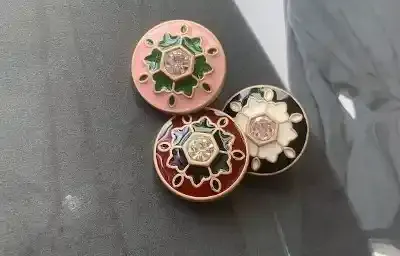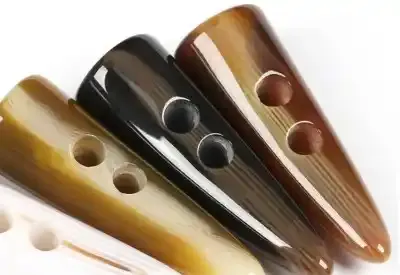Buttons in Garments
Buttons have been a crucial component of garments for centuries, serving both functional and decorative purposes. These small fasteners not only hold together different parts of clothing but also contribute to the overall aesthetic appeal. In the realm of fashion, buttons play a significant role in enhancing style, adding detail, and conveying messages through their design choices. Here we will describe the significance of buttons in garments, highlighting their historical importance and contemporary relevance.
Historical Importance
Buttons have a rich history dating back thousands of years. They were initially made from natural materials such as bone, shell, or wood before evolving into metals like copper and brass during ancient civilizations. Historically, buttons served as status symbols and markers of wealth due to their scarcity and craftsmanship.
During the medieval period in Europe, precious metals like gold or silver were used for buttons worn by royalty or high-ranking individuals. Button-making guilds emerged during the Renaissance era when trade routes expanded access to exotic materials like silk threads and gemstones for creating intricate designs.
The Industrial Revolution brought about mass production techniques that made buttons more accessible to all strata of society. With advancements in manufacturing technology came new button innovations such as self-shank buttons (buttons with attached loops) or detachable stud-like closures used on tuxedos.
Functional Purpose
While buttons certainly possess historical significance as objects symbolizing power or luxury, they primarily serve practical functions within garments even today. Whether it's securing shirts or dresses at strategic points like cuffs or collars, closing jackets or coats along the front opening lines called plackets, or fastening trousers at waistbands - these tasks would be cumbersome without proper closure systems provided by well-designed buttons.
Each type of garment requires specific button styles tailored to its purpose: large statement-buttons may adorn outerwear while smaller delicate ones grace blouses; durable metallic studs may withstand repeated washing while fabric-covered variants ensure seamless integration with garments made from delicate materials.
Types of Buttons in Garments
Buttons play a crucial role in the design and functionality of garments. They not only serve as functional closures but also contribute to the overall aesthetic appeal of clothing items. From simple plastic buttons to ornate metal ones, there is a wide variety of button types available for different purposes and styles.
i. Sew-through Buttons
Sew-through buttons, also known as two-hole buttons, are one of the most commonly used button types in garments. As their name suggests, these buttons feature two holes through which thread can be sewn to attach them securely to fabric. Sew-through buttons come in various sizes, shapes, and materials such as plastic, wood, or shell.
ii. Shank Buttons
Unlike sew-through buttons, shank buttons do not have holes for sewing directly onto fabric. Instead, they have a protruding loop (shank) on their backside through which thread can be passed to attach them securely to garments. Shank buttons provide more depth between the button and fabric surface and allow room for thicker fabrics or multiple layers.
iii. Snap Buttons
Snap buttons consist of two interlocking components: a socket (female part) and a stud (male part). These components snap together when pressed firmly and separate when pulled apart gently. Snap buttons offer quick closure options for fastening garments without requiring any sewing or stitching.
iv. Toggle Buttons
Toggle buttons add both style and functionality to clothing items like coats or jackets by providing secure closures against colder weather conditions or strong winds. The toggle consists of a bar with one or more loops attached at one end while the other end has corresponding openings stitched into it.
v. Rivet Style Button
Rivet-style buttons often seen on denim jeans provide durability due to their sturdy construction. They are typically made from metals such as copper or brass, and they require special tools to attach them securely to the fabric.
vi. Covered Buttons
Covered buttons consist of a button form covered with fabric matching the garment's material. This type of button allows for customization as it can be made from any desired fabric, providing a seamless look when used in garments.
vii. Shank-less Buttons
Shank-less buttons resemble sew-through buttons but lack the protruding loop (shank). They have holes through which thread is sewn directly onto the fabric. These buttons offer a flat surface against the garment and work well on lightweight fabrics or when a minimalistic aesthetic is desired.
These are just a few examples of the many types of buttons used in garments. Each type serves specific purposes based on functionality, design, and personal preferences of fashion designers or individuals involved in garment production. The choice of button type can significantly impact the overall appearance and usability of clothing items, making it essential to consider various factors such as fabric thickness, style requirements, and durability when selecting appropriate buttons for garments. Ultimately, whether for practicality or aesthetics, choosing the right button contributes to enhancing both functionality and visual appeal in fashionable attire.
Aesthetic Enhancement
Beyond their functional purpose, buttons contribute significantly to the overall aesthetic appeal of garments. Fashion designers meticulously select button styles, sizes, colors, and materials to complement or contrast with the fabric's texture and color scheme. The choice of buttons can transform a basic garment into a fashion statement.
Buttons also serve as decorative elements in areas where they may not necessarily function as fasteners. For instance, ornamental buttons along the back seam of a dress or down the sides of trousers create visual interest and add unique touches to otherwise simple designs.
Conveying Style and Messages
Buttons offer designers a means to convey style preferences or even messages through subtle design choices. Engraved initials on cufflinks symbolize personalized luxury while branded logos embossed on buttons represent designer affiliations. Novelty buttons imprinted with motifs like flowers, animals, or geometric patterns express individuality and creativity.
Moreover, buttons can be used to evoke specific themes or historical references within fashion collections; nautical-themed clothing often features anchor-shaped buttons or sailor-inspired designs that use brass-buttoned accents reminiscent of naval uniforms.
Conclusion
The humble button has evolved from its early origins as mere practical fasteners to become an integral component in the world of fashion design. Buttons not only fulfill their primary role by securing garments but also enhance aesthetics through careful selection based on size, color, and material choice - allowing them to blend seamlessly or make bold statements when paired with various fabrics.
From ancient times when they denoted social status to today's modern interpretations serving both functional necessities and artistic expressions - it is evident that buttons continue to hold immense significance in shaping our wardrobes and reflecting our personal style choices.



















0 Comments